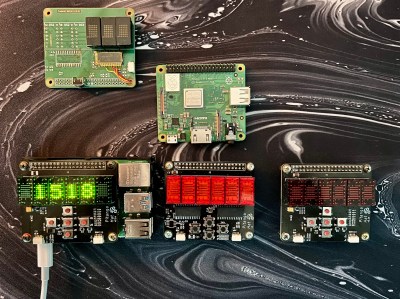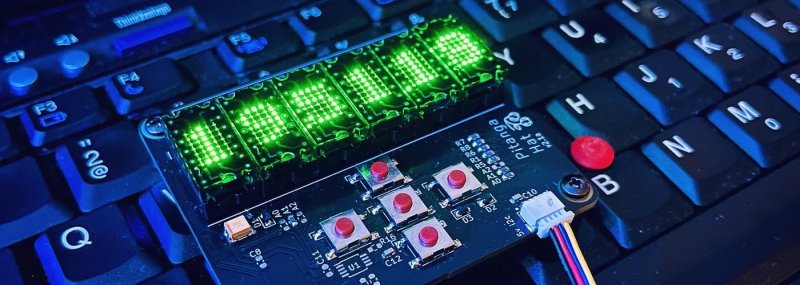Mick Jagger famously said that you cain’t always get what you want. But this is Hackaday, and we make what we want or can’t get. Case in point: [Andrew Tudoroi] is drawn to retro LEDs and wanted one of Pimoroni’s micro-LED boards pretty badly, but couldn’t get his hands on one. You know how this ends — with [Andrew] designing his first PCB.
The Pitanga hat is equally inspired by additional fruit that [Andrew] had lying around in the form of an 8devices Rambutan board. (Trust us, it’s a fruit.) With some research, he discovered the HT16K33 LED driver, which checked all the boxen.
 The first version worked, but needed what looks like a couple of bodge wires. No shame in that! For the next revision, [Andrew] added buttons and decided to make it into a Raspberry Pi HAT.
The first version worked, but needed what looks like a couple of bodge wires. No shame in that! For the next revision, [Andrew] added buttons and decided to make it into a Raspberry Pi HAT.
This HAT is essentially a simple display with a basic input device, and a beauty at that. You can see all the various cool displays that [Andrew] tried both here and in the project log. Although he included pads for an ARM M0 microcontroller, he never did populate it. Maybe in the future.
Of course, this project was not without its challenges. For one thing, there was power compatibility to wrestle with. The Pi can sometimes work with I²C devices at 5 V, but this isn’t ideal long-term. So [Andrew] put the LED driver on the 3.3 V I²C bus. Despite the data sheet calling for 4.5 to 5.5 V, the setup worked fine. But for better reliability, [Andrew] threw a dedicated I²C logic level converter chip into the mix.
Don’t forget, you can run a noble amassment of HATs with the PiSquare.
















The Holtek HT16K33 LED/keyboard driver IC is at End Of Life (EOL) as of April 30, 2022. It is replaced by the HT16K33A with a release date of 31-March-2022. See here:
https://www.holtek.com/webapi/168740/EOL_HT16K33.pdf
The HT16K33A is here:
https://www.holtek.com/page/vg/HT16K33A
See all Holtek LED controller/driver ICs here:
https://www.holtek.com/products/100417/100469/100640#100640
Note: all the Holtek LED controller/driver ICs have a nominal operating voltage of 4.5V-5.5V only.
Holtek Semiconductor is a Taiwan-based semiconductor design center and provider with its headquarters and design operations based in the Hsinchu Science Park in Taiwan, and has sales offices located the United States and India. More:
https://en.wikipedia.org/wiki/Holtek
Thanks for pointing that out! Indeed, Holtek LED driver ICs have a nominal operating voltage of 4.5V–5.5V, but in practice, they tend to work fine at 3.3V.
To ensure proper operation, I added a dedicated I2C logic level translator and included two Qwiic connectors, one at 3.3V and another at 5V. These connectors allow easy integration with other peripherals on the Raspberry Pi’s I2C bus.
As for the HT16K33A, it should work just fine as a drop-in replacement for the HT16K33. That said, given the scarcity of 5×7 micro LED displays nowadays, almost reaching unobtanium status, the transition between these chips is probably the least of the problems! 🙂